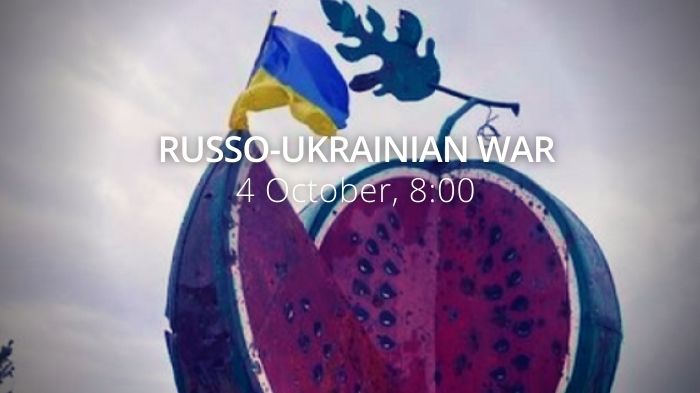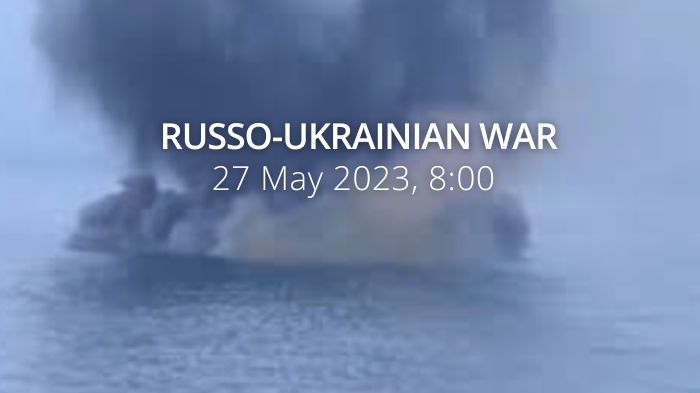Morning report day 101 – June 04: Situation
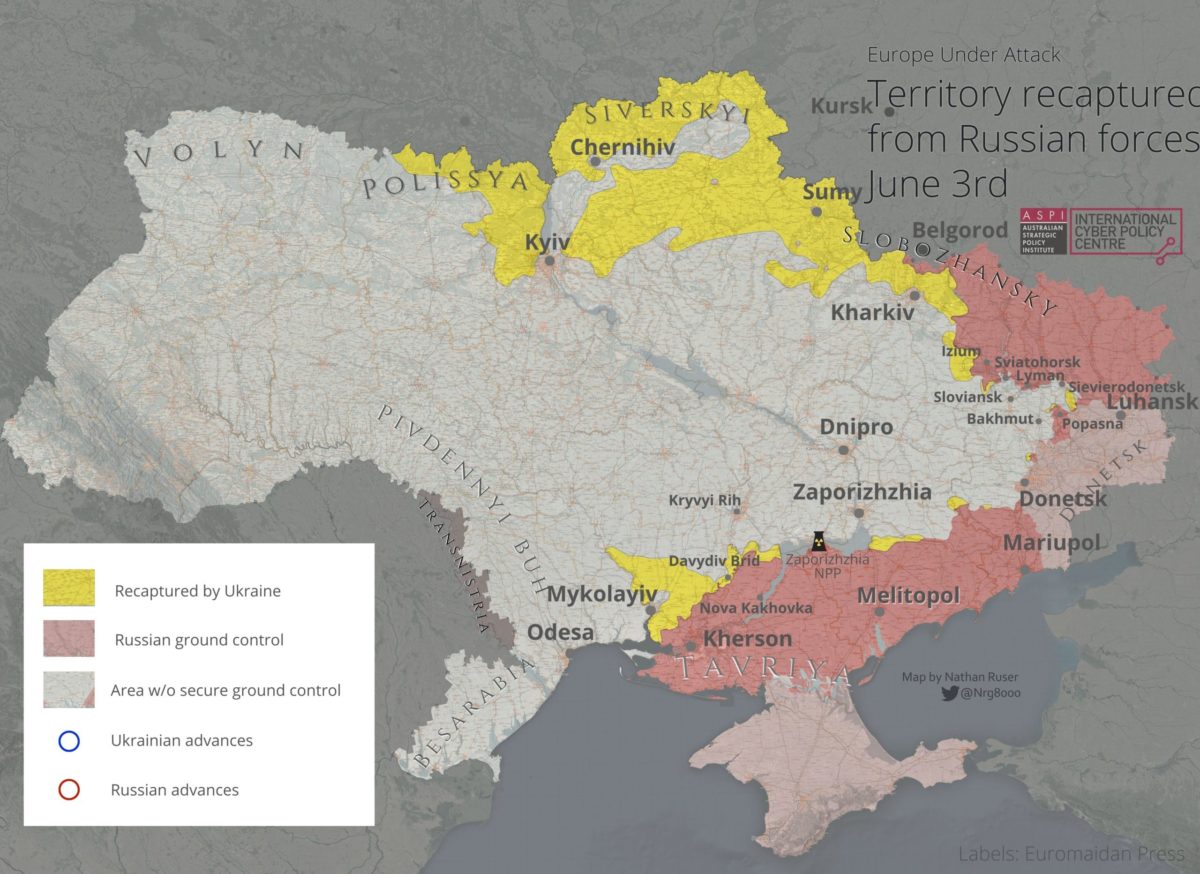
Active hostilities continue in Luhansk Oblast.
Kharkiv Oblast: battles near the Russian border. Russia counterattacks Ukrainian troops with aircraft and artillery. The biggest battles are in the area of Ternova and on the approaches to Ruski Tyshky. Despite fairly active hostilities, the Kharkiv direction is secondary.
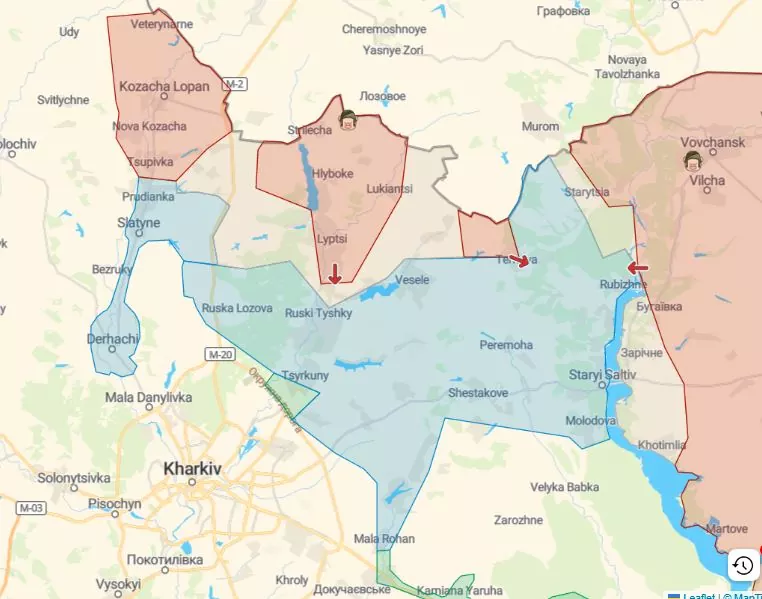
Sloviansk direction: Russia storms Sviatohirsk from the east. The Armed Forces control the heights above the city, thanks to which they accurately fire at enemy forces. Ukraine holds Bohorodychne and Dovhenke.
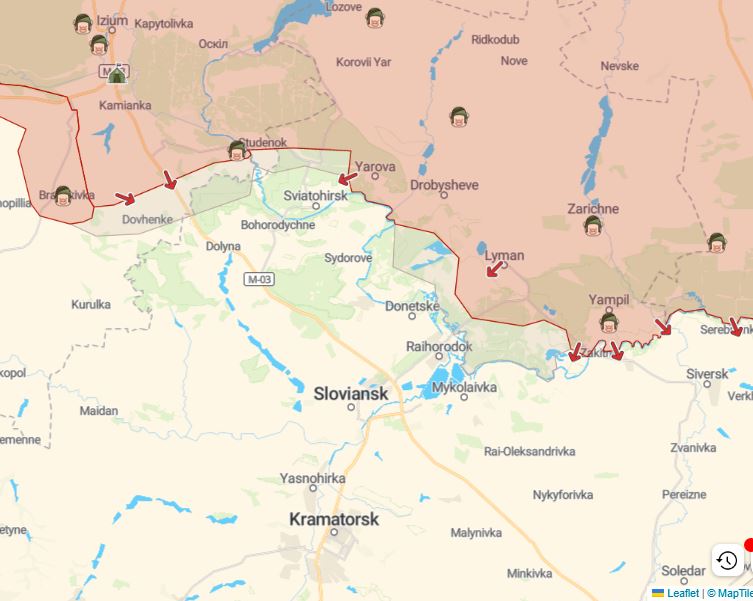
Luhansk Oblast: street fights for Sievierodonetsk continue, in which the Ukrainian Army confirms its status of master of urban battles. Luhansk regional Head Serhiy Haidai wrote on the evening of 3 June that as a result of Ukrainian counterattacks, Ukraine won back 20% of the city, which means Ukrainian forces control roughly 50% of Sievierodonetsk, and regained control over Metolkino. Fighting is also going on north (Privolye) and south (Ustinovka) from Lysychansk; Russians aim to capture both cities.
https://twitter.com/EuromaidanPress/status/1532790189537562625
To the west of Lysychansk, the Armed Forces pushed back the Russians from Bilohorivka, where Russian troops are once again trying to force the Siverskyi Donets. Russia also tries to force the river near Serebrianka.
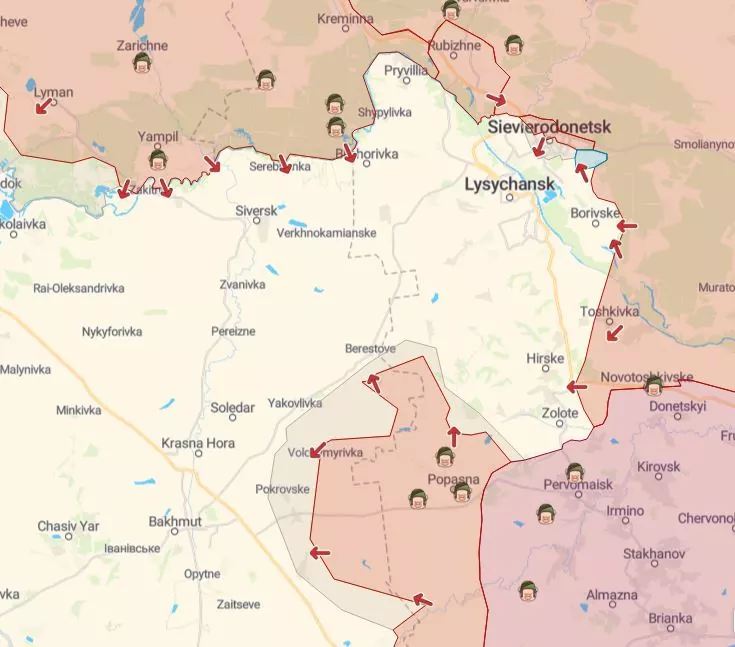
Fierce fighting continues in the Bakhmut-Soledar sector. The Russians, with the help of Wagner PMC, pushed Ukrainians away from Pylypchatyno. Despite intense efforts, Russia still can't block the Bakmut-Lysychansk road. Fighting for Komyshevakha continues north of Popasna.
Donetsk Oblast: in the area of Svitlodarsk, fights are ongoing for Novoluhansk; overall, there is fighting along the entire line of contact without much success for both sides.
Kherson Oblast: no signs of a continuation of the Ukrainian offensive Forces in the direction of Nova Kakhovka. On the way of Ukrainian troops lies Bruskynske, which the Russians have turned into a strong stronghold. It seems that Ukraine has stopped preparing for further action.
While Ukraine is repelling the Russian invasion, Lukashenka continues to maneuver equipment near the Ukrainian border.
Information from the General Staff as of 06.00 04.06.2022, supplemented by its [18:00 assessment], is in the drop-down menu.
The situation in the Volyn and Polissya directions has not changed significantly.
- [No signs of the formation of offensive groups were found. On June 1, combat training of units of the Armed Forces of the Republic of Belarus began at the Vyzhlovichi test site in the Brest region. The threat of missile strikes from the territory of the Republic of Belarus remains.]
[In the Siversky direction, Russian forces did not take active action, and no signs of the formation of strike groups were found. To clarify the location of the positions of our troops, Russian forces conducted reconnaissance with UAVs in some areas of Sumy and Chernihiv oblasts. It fired a missile at the settlement of Krasnopillya in the Sumy oblast and fired mortars at the settlement of Mykhalchyna Sloboda in the Chernihiv oblast.]
- To strengthen certain areas of the border and restrain the actions of our troops, Russian forces continue to hold units of the armed forces of the Russian Federation in the border areas of Bryansk and Kursk regions.
Fighting continues in the Slobozhansky direction. In the direction of the settlement of Shipuvate, the movement of a column of equipment with fuel and ammunition was noted. In the opposite direction, the evacuation of damaged weapons and military equipment (up to 100 units) is carried out. [Russian forces are concentrating their main efforts on restraining the advance of our troops in the direction of the State Border. They continued to fire on units of the Defense Forces using aircraft, artillery, multiple rocket launchers, mortars and tanks. Exploration to find weaknesses in the defence of our troops and determine further areas of action is underway. Logistical support and strengthening of enemy troops are not stopped.]
- In the Kharkiv direction, the main efforts of the occupiers are focused on maintaining the occupied borders. The intense fire continues on the units of the Defense Forces in the areas of the settlements of Hlyboke, Ruski Tyshky, Staryi Saltiv and Cherkasy Tyshky. Russian forces fired a missile at a transport infrastructure facility near the town of Mokhnach. [Russian forces continue to defend themselves, destroying civilian objects in the city of Kharkiv. They launched an airstrike by Mi-8 helicopters at the positions of our troops in the areas of the settlements of Slatyne and Dementiyivka.]
Russian missile destroyed "Metalist" Football Club base in Kharkiv Oblast
The missile launched from the Russian city of Belgorod hit the building, leaving a funnel 5 m deep.https://t.co/NVaxOXzKNv pic.twitter.com/fjU5y1w89c
— Euromaidan Press (@EuromaidanPress) June 4, 2022
- [In the Sloviansk direction, Russian forces are preparing to resume the offensive, concentrating a group of up to twenty battalion tactical groups. To improve the tactical situation, it tried to launch an offensive in the directions of the settlements of Barvinkove and Sviatohirsk yesterday, but was unsuccessful.] To reduce the combat potential of our troops, Russian forces carried out artillery shelling of the settlements of Hrushuvakha, Tetyanivka and Dibrivne. He carried out assault operations in the direction of the settlement of Bogorodychne but had no success. He led an unsuccessful offensive in the direction of the village of Vernopilla and suffered casualties.
https://twitter.com/EuromaidanPress/status/1533054620687290368
In the Donetsk direction, Russian forces fire at the positions of our troops along the entire line of contact with mortars, artillery and MLRS. Uses operational-tactical and army aviation.
- The main efforts are focused on the Sievierodonetsk and Bakhmut areas.
- With the support of artillery, Russian forces are storming the town of Sievierodonetsk, strengthening the group at the expense of the mobilization reserve of the 2nd Army Corps, and fighting continues in the city.
- The occupiers launched an offensive in the direction of the village of Ustynivka but were unsuccessful.
- [Yesterday, Russian forces conducted an offensive in the directions of the settlements of Bakhmut, Soledar and Lysychansk. Has no success, retreated to previously held positions.] In the Bakhmut direction, with the support of artillery, Russian forces last night were advancing, had no success, according to the results of the fire damage from Ukrainian units, retreated.
- In the Avdiivka and Kurakhiv directions, Russian forces are conducting restraining and distracting actions.
- In the Lyman direction, near the settlement of the Staryi Karavan, the occupiers are trying to take control of the left bank of the river Siversky Donets.
- [Russian forces did not wage active hostilities in the Avdiivka, Kurakhiv, Novopavliv, and Zaporizhzhia directions. Mortar, MLRS and artillery shelling were recorded in the areas of Pisky, Mykolaivka, Poltavka and Pokrovske settlements.]
- The rate of advance of enemy units during hostilities in the Donetsk direction is low, due to the physical exhaustion of personnel and low moral and psychological condition.
- In the past 24hrs, nine enemy attacks have been repulsed in Donetsk and Luhansk, one tank, one artillery system, six armoured combat vehicles, two special armoured vehicles and three units of motor vehicles have been destroyed. Air defence units shot down a cruise missile, a tactical reconnaissance UAV "Eleron" and two UAV type "Orlan-10".
In the Pivdennyy Buh direction, Russian forces are conducting static defence and trying to carry out fire damage to our units. [Russian forces are defending, but are trying to regain lost ground in some areas. It carried out artillery fire and intensified air reconnaissance.]
- The invaders are afraid of the resistance of the local population, which is growing in particular in the Kherson oblast. The leadership of the occupiers moves with a lot of security, in bulletproof vests, in armored vehicles. Locals continue to put up total resistance.
- [The situation in the Bessarabian direction has not changed significantly. No signs of the formation of enemy offensive groups were found.]
[The main efforts of enemy naval groups in the Black Sea and the Sea of Azov are focused on isolating combat areas and blocking civilian shipping in the northwestern Black Sea.]
- Three carriers of naval-based cruise missiles of the "Caliber" type are ready for the use of missile weapons in the Black Sea.
[Forced mobilization of civilians continues in the temporarily occupied territory of Donetsk oblast. Threatening criminal responsibility, the command of the occupying forces is trying to make up for the losses of units they suffered in the fighting against the defenders of Ukraine.]
[According to available information, the command of the armed forces of the Russian Federation is taking measures to intensify reconnaissance and sabotage activities in Ukraine. To this end, the recruitment and training of mercenaries for the formation of sabotage and reconnaissance groups with their subsequent activities in Ukraine. Preference in the implementation of this selection is given to residents and former residents of Donetsk and Luhansk oblasts who are fluent in the Ukrainian language.]”
The Ukrainian military has pushed Russians back from two settlements in the Sievierodonetsk direction, Ukrinform reports. “In the Sievierodonetsk direction, Ukrainian forces have thwarted the attempts by Russian occupiers to seize such settlements as Metiolkine and Bilohorivka. Russian forces suffered losses and retreated. This morning, with the support of aviation, Russian forces have been conducting assault operations within residential areas in the central part of Sievierodonetsk. Again, they are suffering losses. At the moment, active hostilities are underway, [the Ukrainian Defense Ministry Spokesperson Oleksandr Motuzianyk said].”
Sievierodonetsk remains unseized, fierce battles raging on streets – Haidai, Ukrinform reports. “Now Luhansk Region is an outpost of Ukraine, and lots of Russian invasion forces are concentrated here. Today, fierce battles are raging in Sievierodonetsk. By the way, Kadyrov’s men reported they had captured the city. It is a lie, as battles are raging in the city. Heavy battles, directly in the city of Sievierodonetsk,” [the Head of Luhansk Regional Military Administration, Serhii Haidai Haidai, said in his video address on Telegram].”
Ukraine has retaken about 20% of territory lost in Sievierodonetsk -regional head, Reuters reports. “Ukrainian forces have recaptured around 20% of the territory they lost in the city of Sievierodonetsk during fighting with Russia, the head of the eastern region of Luhansk said on Friday. Whereas before the situation was difficult, the percentage (held by Russia) was somewhere around 70%, now we have already pushed them back by approximately 20%," Serhiy Gaidai told national television. As soon as we have enough Western long-range weapons, we will push their artillery away from our positions. And then, believe me, the Russian infantry, they will just run."
According to British Defence Intelligence, (last 24 hours):
- Russian air activity remains high over contested ground in the Donbas with Russian aircraft conducting strikes using both guided and unguided munitions. Russia’s inability to suppress or destroy Ukrainian strategic air defence systems in the opening days of the conflict limited its ability to provide tactical air support to ground manoeuvre elements, contributing to the failure to advance on Kyiv.
- Consequently, Russian air activity has been largely restricted to deep strikes using air and surface launched cruise missiles to disrupt the movement of Ukrainian reinforcements and supplies. These strikes alone however have failed to have a meaningful impact on the conflict and Russian stocks of precision guided missiles are likely to have been significantly depleted as a result.
- With its operational focus switching to the Donbas, Russia has been able to increase its employment of tactical air to support its creeping advance, combining airstrikes and massed artillery fires to bring its overwhelming firepower to bear.
- The combined use of air and artillery strikes has been a key factor in Russia’s recent tactical successes in the region. The increased use of unguided munitions has led to the widespread destruction of built-up areas in the Donbas and has almost certainly caused substantial collateral damage and civilian casualties.
As of Friday 3 June, the approximate losses of weapons and military equipment of the Russian Armed Forces from the beginning of the war to the present day:
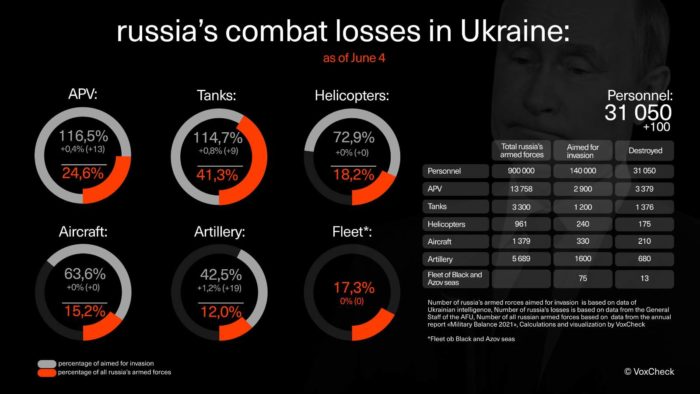
- Personnel – more than 30950 (+100),
- Tanks – 1367 (+4),
- Armoured combat vehicles – 3366 (+12),
- Artillery systems – 675 (+14),
- Multiple rocket launchers –MLRS - 207 (+0),
- Air defence means – 95 (+1),
- Aircraft - 210 (+0),
- Helicopters - 175 (+0),
- Automotive technology and fuel tanks – 2329 (+4),
- Vessels/boats - 13 (+0),
- UAV operational and tactical level – 535 (+14),
- Special equipment – 51 (+0),
- Mobile SRBM system – 4 (+0),
- Cruise missiles – 121 (+1),
Humanitarian
Russian occupiers to ban Mariupol residents from leaving their neighbourhoods, the Ukrainska Pravda reports. "Yesterday [2 June - ed.] a decision to strengthen the filtration regime was taken during a big meeting of the Russian military, the occupation authorities and [their Ukrainian] collaborators in Mariupol, [Petro Andriushchenko, advisor to the mayor of Mariupol, wrote on Telegram]
It has been decided to make it de facto impossible to move between the city’s neighbourhoods or to leave the city by dragging out procedural delays. There are two reasons for this: the growing discontent within the city, and the uncontrolled information leaks [from Mariupol - ed.] to Ukraine. Therefore, search and enforcement units will be reinforced and the searches for Ukrainian activists will be intensified."
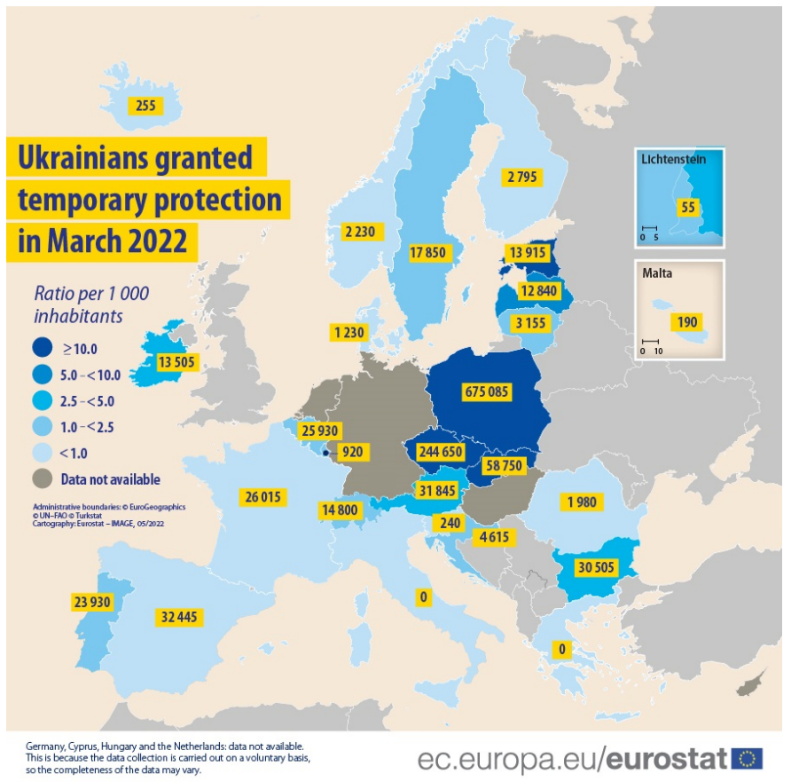 Poland takes in most Ukrainians fleeing war in March, EU figures show, Reuters reports. “Poland was the European Union country that in March granted temporary protection to the highest number of Ukrainians fleeing war, while other countries have since increased how many people they are sheltering, EU data showed on Friday. Eurostat data released on Friday showed that Poland in March granted temporary protection status to 675,085 Ukrainians, followed by the Czech Republic which gave the status to 244,650 and Slovakia to 58,750.
Poland takes in most Ukrainians fleeing war in March, EU figures show, Reuters reports. “Poland was the European Union country that in March granted temporary protection to the highest number of Ukrainians fleeing war, while other countries have since increased how many people they are sheltering, EU data showed on Friday. Eurostat data released on Friday showed that Poland in March granted temporary protection status to 675,085 Ukrainians, followed by the Czech Republic which gave the status to 244,650 and Slovakia to 58,750.
In Poland, two-thirds or more of Ukrainians given temporary protection status were women and girls, while children - aged under 18 years old - accounted for more than half of them. Based on the data available so far for April, Eurostat said that the number of Ukrainians given temporary protection had increased from March in nine EU member states, led by Bulgaria and Lithuania, which welcomed 30,965 and 21,800 more people, respectively.”
According to UNHCR 6,938,041 refugees have been registered as of June 1. The UN says that so far Poland has taken in (border crossings) 3,690,089 refugees, Russian Federation 1,041,095, Hungary 698,420, Romania 587,219, Republic of Moldova 483,306, Slovakia 466,264 and Belarus 16,648. Among those who fled Ukraine are also Ukrainian nationals with dual citizenship. An additional 105,000 people moved to the Russian Federation from the Donetsk and Luhansk regions between 18 and 23 February.
The number of border crossings to Ukraine since February 28 is 2,102,047 as of June 1. This figure reflects cross-border movements, which can be pendular, and does not necessarily indicate sustainable returns.
OHCHR recorded 9,197 civilian casualties in Ukraine as of June 2. 4,183 were killed (including 268 children) and 5,014 injured (including 427 children).
Environmental
Russian-held nuclear plant faces a critical shortage of spare parts, says Kyiv, Reuters reports. “The plant in the southeastern region of Zaporizhzhia was occupied by Russian troops shortly after its Feb. 24 invasion, but the facility is still operated by Ukrainian technicians. A critical situation has developed at the ... plant in terms of ensuring stable and safe operations. There are practically no spare parts and expendable materials left, the Defence Intelligence of the Ministry of Defence said.
The facility is being operated by week-long rotations of staff who have all of their personal belongings and phones taken from them when they begin, it said in a statement.”
100 days of war: Ukraine's Armed Forces liberated 1,017 settlements, 370 demined, Ukrinform reports. "During this time, Ukraine's Armed Forces liberated 1,017 settlements from the invaders, 370 of them have already been demined, whereas, in others, the State Emergency Service is working, Deputy Head of the Ukrainian President's Office Kyrylo Tymoshenko said.
He noted that in the liberated territories of Kyiv, Kharkiv, Chernihiv, Sumy and Zhytomyr regions, work has already begun on the restoration of residential buildings and social infrastructure. As of June 3, 1,194 facilities have been completely restored, he said.
Tymoshenko also noted that in the liberated cities, transport services are gradually being restored. In particular, they have already been restored in more than 700 settlements. He added that medical facilities are operating in 26% of the liberated area, grocery stores have reopened in more than 600 settlements and banks in almost 300. In addition, humanitarian goods are delivered to Ukraine every day. In May alone, more than 126,000 tonnes of humanitarian aid were sent to the country, the official said.”
Legal
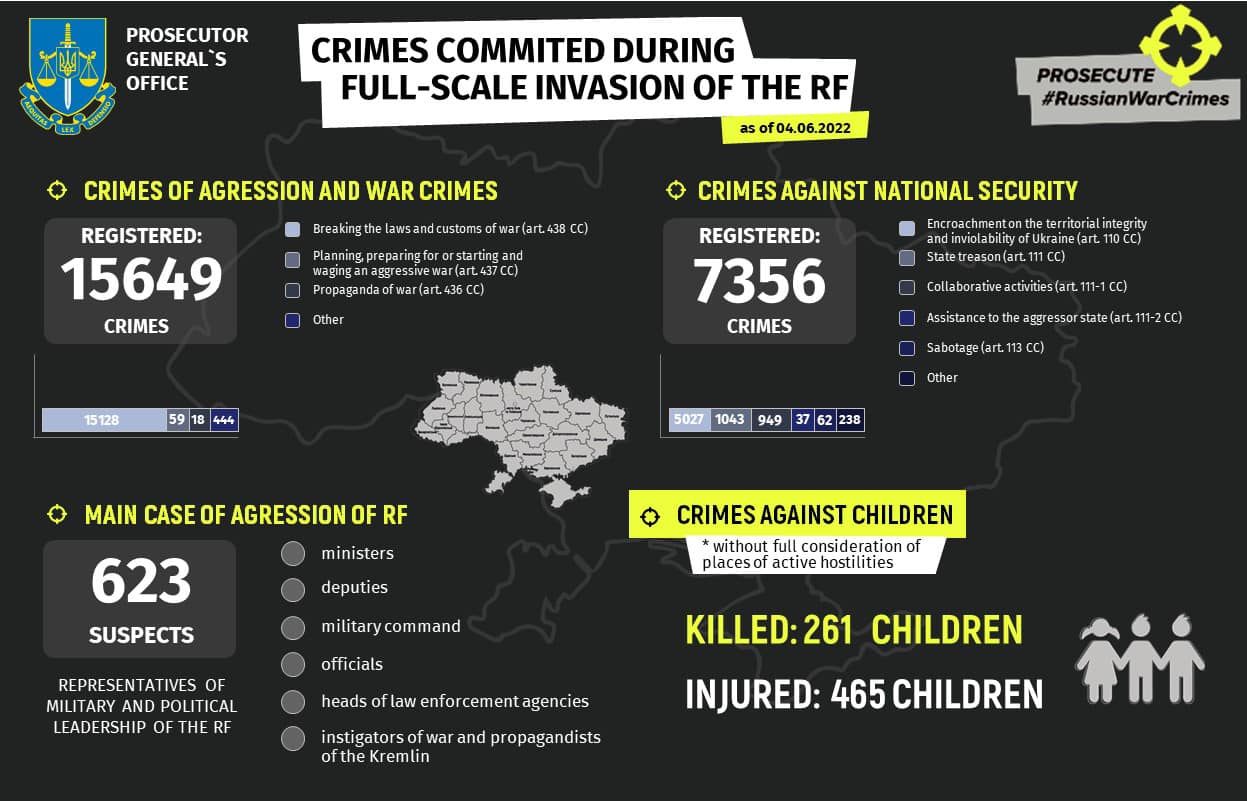 261 children were killed, and 465 children injured, the Office of the Prosecutor General of Ukraine reports as of June 4. 1,938 educational establishments are damaged as a result of shelling and bombings, 182 of them are destroyed fully. 15,649 crimes of aggression and war crimes and 7,356 crimes against national security were registered.
261 children were killed, and 465 children injured, the Office of the Prosecutor General of Ukraine reports as of June 4. 1,938 educational establishments are damaged as a result of shelling and bombings, 182 of them are destroyed fully. 15,649 crimes of aggression and war crimes and 7,356 crimes against national security were registered.
EU will never recognize the forceful integration of Ukrainian territories into Russia, Ukrinform reports. “Any attempts to alter the status of parts of Ukrainian territory are a clear violation of international law, the UN Charter and Ukraine’s Constitution, they further undermine the sovereignty and territorial integrity of Ukraine, and will not be recognized by the European Union. That’s according to a Declaration by the High Representative on behalf of the EU.
The European Union has also strongly condemned the Russian Presidential decrees of May 25 and May 30, simplifying the process for granting Russian citizenship and issuing Russian passports to Ukrainian citizens of the Kherson and Zaporizhzhia regions which are temporarily under military control of Russian invading troops, as well as to Ukrainian children without parental care and legally incapacitated persons from Donetsk, Luhansk, Kherson and Zaporizhzhia regions. The European Union says it will not recognize these passports, issued as part of Russia’s war of aggression against Ukraine.”
Support
Private groups work to bring specialized combat gear to Ukraine, The Washinton Post reports. “A network of former military veterans is providing commercially available equipment they say is lacking in front-line units engaging Russian forces, often at close range.
The Washington Post interviewed Chris in May and verified his military credentials through official service records. He’s part of a small, shadowy network of former military personnel and small-scale contractors aiding Ukraine’s war effort by providing advanced, commercially available combat gear to front-line units engaging Russian forces at close range. Such efforts, they say, enable Ukraine to exploit the vulnerabilities of what is generally a larger, more technologically advanced Russian military by targeting and taking out forces as they approach.
It’s a delicate venture, one that involves close scrutiny of US laws governing the sale and distribution of sensitive military equipment, people familiar with the effort say. At least three members of Congress have been approached by groups seeking guidance on how to speed applications for government approval to export materiel that is closely regulated. […]
Ad hoc groups working to help the Ukrainians say certain Western military aid is not getting where it needs to be fast enough or in sufficient supply. “There is a massive disconnect from the very top to the guy on the front lines,” said Ryan Gisolfi, co-founder of Delta Level Solutions, a security firm established this year that is helping move military equipment obtained independently of Western governments to special operations units in Ukraine. […]
“The military aid packages that are moving through, they are … not night-vision goggles and they’re not body armor,” Rawlings said in an interview from Kyiv. “So we’ve filled a niche — and the niche is large.” […]
To date, most groups that have managed to do this work successfully have focused on things like medical supplies, vehicles and communications equipment. Project SIRIN’s attempt to move military materiel brings a series of extra hurdles. Military-grade weapons are tightly controlled, so while the group waits for the US government to approve its export license, it buys specialized equipment from domestic and foreign distributors, including firms that cater to dedicated hobbyists with high-end gear. […]”
PM Shmyhal calls on international companies to return to Ukraine, Ukrinform reports. “I’d like to appeal to all international companies that have worked in Ukraine. Resume your work now, as most Ukrainian companies have done in safe regions. The government will help you as much as possible. Stopping work in Ukraine is a sanction against our economy. Your return will be a manifestation of true solidarity with the Ukrainian people, who are today fighting for their freedom and fighting for a peaceful future for the whole of Europe, the head of government stated.”
US Technology, a Longtime Tool for Russia, Becomes a Vulnerability, The New York Times reports. “Global restrictions on sending advanced technology to Russia are hampering the country’s military capacity, US officials say, though Russia has stockpiled American equipment for years. Over a week’s visit to Ukraine last month, the investigators pulled apart every piece of advanced Russian hardware they could get their hands on, such as small laser range finders and guidance sections of cruise missiles. The researchers, who were invited by the Ukrainian security service to independently analyze advanced Russian gear, found that almost all of it included parts from companies based in the United States and the European Union: microchips, circuit boards, engines, antenna and other equipment.
“Advanced Russian weapons and communications systems have been built around Western chips,” said Damien Spleeters, one of the investigators with Conflict Armament Research, which identifies and tracks weapons and ammunition. He added that Russian companies had enjoyed access to an “unabated supply” of Western technology for decades.
US officials have long been proud of their country’s ability to supply technology and munitions to the rest of the world. But since Russia invaded Ukraine in late February, the United States has faced an unfortunate reality: The tools that Russian forces are using to wage war are often powered by American innovation.
Still, while the technology made by American and European companies has been turned against Ukraine, the situation has also given the United States and its allies an important source of leverage against Russia. The United States and dozens of countries have used export bans to cut off shipments of advanced technology, hobbling Russia’s ability to produce weapons to replace those that have been destroyed in the war, according to American and European officials.”
New developments
- Arakhamiia indicates when Ukraine will resume negotiations with Russia, Ukrainska Pravda reports. “Davyd Arakhamiia, a People's Deputy and the leader of the Ukrainian group negotiating with the Russians, says that Ukraine can initiate a new round of negotiations with the Russian Federation when it has strengthened its negotiating position.”
- MFA Ukraine names three prerequisites for winning the war, Ukrinform reports. “The main prerequisites for Ukraine to achieve victory in the war waged by Russia remain unchanged: maximum sanctions pressure, supplies of required weaponry, and a candidate status on the path to full EU membership. This was stated by the Ministry of Foreign Affairs in a comment marking 100 days of the full-scale Russian invasion of Ukraine.”
- German lawmakers approve 100 bln euro military revamp, Reuters reports. “Germany's Bundestag, the lower house of parliament, on Friday approved the creation of the 100 billion euro ($107.2 billion) special defence fund that Chancellor Olaf Scholz announced in response to Russia's invasion of Ukraine. The money is destined to top up the regular defence budget of around 50 billion euros over several years to help rebuild Germany's military, which has suffered years of neglect following the end of the Cold war. The fund should enable Germany to meet the NATO target of spending 2% of its economic output on defence each year, making it the world's third-biggest military spender behind the United States and China.”
- Russia says Germany is risking European security by 'remilitarizing', Reuters reports. “In comments published in German newspapers this week, Chancellor Olaf Scholz said Berlin would soon have the largest conventional army of NATO's European members. We perceive the statement of the German Chancellor as yet another confirmation that Berlin has set a course for an accelerated remilitarization of the country. How could this end? Alas, this is well known from history, Russian Foreign Ministry spokeswoman Maria Zakharova said”.
- Putin proposes that Ukraine export grain through destroyed Mariupol or Belarus, Ukrainska Pravda reports. “Russian President Vladimir Putin has stated that Russia is prepared to ensure the export of Ukrainian grain through the Russian-occupied ports of Berdiansk and Mariupol and to guarantee the peaceful passage of grain ships to international waters from ports under Ukrainian control.”
Assessment
1. On the War
The Institute for the Study of War has made the following assessment as of Friday 3 June:
“
Russian Defense Minister Sergey Shoigu claimed that Russian forces will “accelerate” the “special military operation” in Ukraine in a meeting with Chechen Leader Ramzan Kadyrov on June 3, though Russian forces are unlikely to be able to do so. Kadyrov said that Shoigu has “identified new tasks” that will improve the effectiveness of Russian offensive maneuvers and improve Russian tactics. Kadyrov did not specify which tasks Russian forces will undertake to speed up their pace. Shoigu previously claimed on May 24 that Russian forces were making slow progress in eastern Ukraine to avoid civilian casualties. In a retrospective on the 100th day of the war, the UK Defense Ministry stated that Russian forces will likely establish control over Luhansk Oblast in the next two weeks, though only at significant further cost. The UK Defense Ministry further noted that Russian forces on all other axes have gone over to defensive operations to concentrate all available forces in Sievierodonetsk, and stated Russia will need to commit sizable investment of manpower and equipment—that it will be unable to generate quickly, if at all—to advance beyond Luhansk Oblast.
A Russian milblogger published a lengthy message on June 3 claiming that nearly the entire 35th Combined Arms Army has been destroyed in Izium due to incompetent Russian commanders. A Russian milblogger under the pseudonym Boytsovyi Kot Murz said that Russian commanders did not account for combat challenges in the Izium woods, leading to significant losses in the 64th and 38th Separate Guard Motor Rifle Brigades, which he reported now have less than 100 servicemen in total. Boytsovyi Kot Murz claimed that Russian commanders failed to provide necessary equipment to units fighting in wooded terrain and did not repair Russian heavy artillery in a timely manner. Russian forces also reportedly lacked effective communication with command centers and relied on messengers due to the shortage of encrypted phones. Boytsovyi Kot Murz noted that the lack of communications between Russian units and commanders allowed Ukrainian forces to strike Russian advanced positions with drones. Russian private military company servicemen from Wagner also refused to participate in combat, leading to a significant lack of advances on the Izium axis. While ISW cannot independently confirm these reports, they are consistent with previous reports of Russian operations and high casualties on the Izium axis.
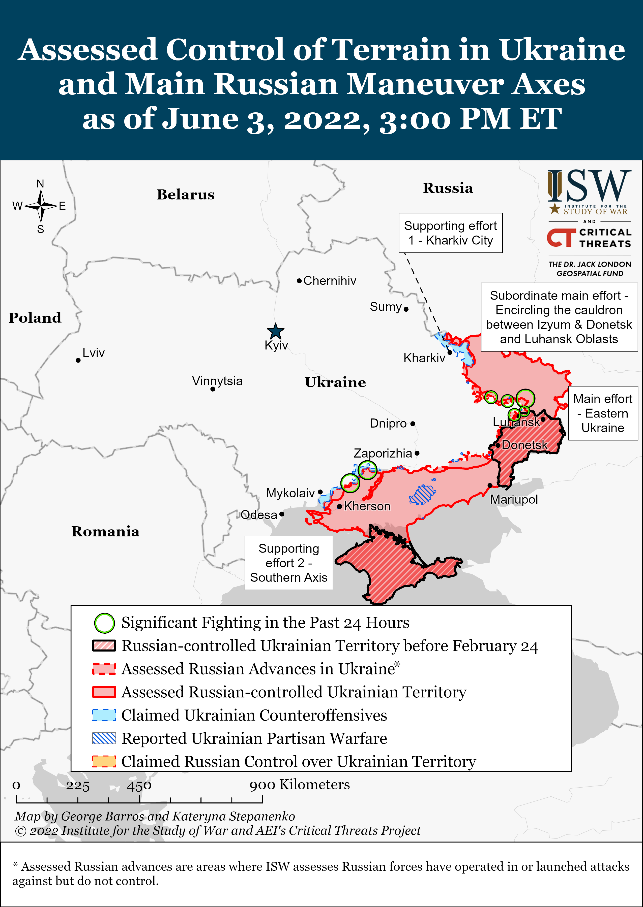 Russian and proxy forces reportedly have not sufficiently prepared frontline units with medical supplies, leading to abysmal medical care. Boytsovyi Kot Murz criticized the Russian Defense Ministry for failing to prepare medical equipment and field hospitals for wounded servicemen. Russian commanders reportedly failed to learn lessons from the lack of medical equipment during the Battle of Debaltseve in 2015 and are repeating similar mistakes. Boytsovyi Kot Murz claimed that Russian forces do not provide frontline troops with high pressure bandages and other supplies necessary to address limb injuries in time. Boytsovyi Kot Murz compared expired and underprepared Russian first aid kits to higher quality Ukrainian supplies and claimed that Russian forces do not have volunteer support that could address the shortages in military equipment. Boytsovyi Kot Murz noted that only Russian infantry, that he claimed has been defeated, had necessary medical training—while newly recruited reservists are incapable of providing first aid. Boytsovyi Kot Murz said that Russian medics are conducting an unnecessary number of limb amputations due to the lack medical equipment provided by the Russian Defense Ministry. These claims are consistent with past reports of poor Russian medical care in frontline units, and these conditions are likely a major contributing factor to Russian demoralization and the growing refusal of servicemen to return to frontline units.
Russian and proxy forces reportedly have not sufficiently prepared frontline units with medical supplies, leading to abysmal medical care. Boytsovyi Kot Murz criticized the Russian Defense Ministry for failing to prepare medical equipment and field hospitals for wounded servicemen. Russian commanders reportedly failed to learn lessons from the lack of medical equipment during the Battle of Debaltseve in 2015 and are repeating similar mistakes. Boytsovyi Kot Murz claimed that Russian forces do not provide frontline troops with high pressure bandages and other supplies necessary to address limb injuries in time. Boytsovyi Kot Murz compared expired and underprepared Russian first aid kits to higher quality Ukrainian supplies and claimed that Russian forces do not have volunteer support that could address the shortages in military equipment. Boytsovyi Kot Murz noted that only Russian infantry, that he claimed has been defeated, had necessary medical training—while newly recruited reservists are incapable of providing first aid. Boytsovyi Kot Murz said that Russian medics are conducting an unnecessary number of limb amputations due to the lack medical equipment provided by the Russian Defense Ministry. These claims are consistent with past reports of poor Russian medical care in frontline units, and these conditions are likely a major contributing factor to Russian demoralization and the growing refusal of servicemen to return to frontline units.
Ukrainian forces report that Russian electronic warfare (EW) units are increasingly threatening Ukrainian air reconnaissance in eastern Ukraine. Ukrainian military officials reported that Russian forces are increasingly jamming all possible signals and hindering Ukrainian drone operations. The Ukrainian General Staff has previously reported that Russian forces intensified EW operations in Donbas, likely in an effort to obstruct Ukrainian aerial reconnaissance and drone strikes on Russian units.
Key Takeaways
- Russian forces conducted unsuccessful assaults southeast and southwest of Izium and west of Lyman but remain unlikely to secure major advances towards Sloviansk.
- Russian forces made minor gains in the eastern part of Sievierodonetsk, but Ukrainian forces continue to launch localized counterattacks in Sievierodonetsk and its outskirts.
- Russian forces did not attempt to launch assaults on Avdiivka.
- Russian forces failed to regain lost positions in northeastern Kherson Oblast and continued to defend previously occupied positions.
- Russian occupation authorities began issuing Russian passports in Kherson City and Melitopol, though they continue to face challenges establishing societal control over occupied territories and ending Ukrainian partisan actions.“
‘They’re in hell’: Hail of Russian artillery tests Ukrainian morale, The Washington Post reports. “Having reached its 100th day, the war between Russia and Ukraine is now at a demoralizing stage for many Ukrainian soldiers. In the trenches of this coal-mining region, they are reeling from brutal Russian artillery onslaughts that call to mind the indiscriminate savagery of World War I. They are holding out hope for victory despite the grim reality of their struggle’s mounting cost, and successfully holding the line in many places to make the Russian fight a painful slog.
Russian forces are killing as many as 100 Ukrainian troops each day and wounding up to 500 more on the eastern front, President Volodymyr Zelensky said this week. At that rate, Ukraine would be losing, in about 2½ months, as many forces as the United States lost in Iraq and Afghanistan over 20 years. In recent days, Ukrainian territory has slipped away incrementally to Russian forces, who according to Zelensky now control 20 percent of the country.
“Russian artillery is shooting from morning until evening,” said Volodymyr Pohorilyy, 43, intelligence commander of the Dnipro-1 battalion, which holds several key positions in the region. “If our side shoots one their way, we get 10 or 15 back.”
The Russian military, having failed in its botched attempt to seize Kyiv and overthrow the Ukrainian government, has regrouped for the second stage of the war. Moscow has redirected nearly all its remaining artillery to a single area. The Kremlin’s hope is to accomplish its new stated goal of taking all of Ukraine’s eastern Luhansk and Donetsk regions, which together comprise Donbas.
“In some respects, this is one war but two distinct campaigns,” said Michael Kofman, a Russian military analyst at Virginia-based CNA. “The first was to decide whether or not Ukraine would survive as an independent state — and Russia lost that conflict decisively. … This second phase is about what territory that independent Ukrainian state will ultimately control, and that remains very much in contest.”
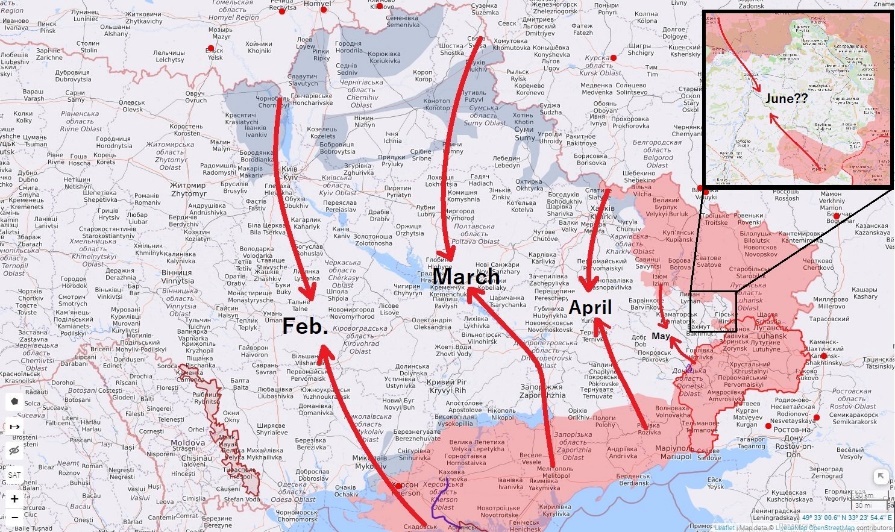
Russia’s catastrophic missteps and embarrassing retreat in the first stage of the war buoyed Ukrainian spirits and resolve. But the barbarity of Russia’s concentrated artillery fire has made the second stage far more challenging for many Ukrainians in the trenches. The war has seen relatively few infantry engagements or tank-on-tank battles; Russia, rather, is concentrating overwhelming artillery power on relatively small areas to blast its way forward in a path of grave destruction.
“They have adopted this technique, which is a World War I technique fundamentally, of using artillery to just obliterate everything in front of them and then crawl over the rubble,” said Frederick W. Kagan, director of the Critical Threats Project at the American Enterprise Institute. He said facing down such artillery bombardments is daunting and devastating for Ukrainian soldiers.
“The amount of firepower, the number of explosions, the length and duration of the attacks — all of that together, and the fact that you can’t defend against it, you can’t shoot down the rounds, means it’s a lot of casualties and it is also incredibly demoralizing,” Kagan said. […]
Moscow is obliterating towns with faraway artillery to minimize its losses and play to the Russian military’s strengths as an artillery-focused force. But Kagan said Moscow is also relying on those tactics because Russian forces have been gutted by casualties and disenchantment from the first phase of the war and have shown an inability to fight successfully otherwise.
The losses Ukrainian forces are suffering are horrible, Kagan said, but they aren’t necessarily going to force Kyiv to capitulate or “lose” the broader war. Even if Russia takes control of all of Donbas, which would be difficult due to Ukraine’s defences, the Ukrainians still have forces that can counterattack and retake territory elsewhere, he noted. Ukrainian troops, for example, recently launched a counteroffensive near the occupied city of Kherson.
Ukraine’s losses are mounting as Ukraine awaits further assistance from the West. […] Russia possesses artillery with longer ranges, allowing Moscow to strike Ukrainian troops from afar. Kyiv lacks such equipment and has less ammunition. In interviews with nearly two dozen troops in recent days, many bemoaned their lack of adequate ammunition, saying they will be unable to push back the Russians and regain Ukrainian territory without significant assistance.”
2. Consequences and what to do?
Hans Petter Midttun: The scale and scope of the Western response to the full-scale invasion have been unprecedented. What has made it even more unique is the fact that it became a reality 2926 days (8 years and 4 days) after the war started. We have seen the West unite in a manner we have not seen since the Cold War.
“In response to Russia’s actions, Allies have activated NATO’s defense plans and deployed thousands of extra troops from both sides of the Atlantic. NATO has also deployed high-readiness elements of the NATO Response Force for the first time in a deterrence and defense role. Over 40,000 troops, along with significant air and naval assets, are now under direct NATO command in the eastern part of the Alliance, supported by the Allies’ national deployments. NATO has established four new multinational battlegroups in Bulgaria, Hungary, Romania, and Slovakia, in addition to the existing battlegroups in Estonia, Latvia, Lithuania and Poland.” The USA has increased its force presence in Europe.
“NATO Allies and partners have imposed unprecedented costs on Russia, including severe sanctions that are helping starve the Kremlin’s war machine of resources. Allies continue to refine the sanctions in order to increase the pressure on Moscow.”
Sweden and Finland have made the historic decision to seek NATO membership. Denmark has decided to join EU defence policy to deepen defence ties in response to Russia's invasion of Ukraine.”
NATO countries are strengthening their defense budgets to re-establish resilience and operational capabilities. German lawmakers have just approved a staggering €100 billion military revamp. This will enable Germany to meet the NATO target of 2% spending of its BNP on defense yearly, making it the world's third-biggest military spender behind the United States and China. Other countries are following its example.
More importantly, the last 100 days have seen tremendous defence support for Ukraine. As of 18 May, the international community had delivered or committed more than €33,6 billion in military support according to the Ukraine Support Tracker. The scale and scope have increased in the weeks that have passed. The USA alone introduced a bill allowing for an additional €19 billion in military aid. The “lend-lease agreement” signed by President Biden on 9 May will result in a further supply of weapons, sensors, ammunition, vehicles, aircraft, and more. Several European countries have boosted their deliverance of heavy weapons, including British MLRS, German Air Defence, and Danish and Swedish Anti-Ship missiles.
Imagine how European security would have been today if we had acted equally resolutely when the war started on 20 February 2014?
The only thing changing on 24 February 2022 was the level of violence and brutality. It was the same war, the same aggressor with the same aim and objectives. Russia was already occupying 19,6% of Ukrainian territory and maritime areas of its jurisdiction. 15,000 had already been killed and approximately 33-34,000 had been wounded in the more than 8 years old war. Ukraine had more than 1,5 million internally displaced people when the full-scale invasion started. The only thing it did not have, was an effective deterrence due to 8 years of Western inaction.
The full-scale invasion is a result of our collective failure to act when challenged. Russia’s war in Ukraine was but one out of its many transgressions in violation of international law since 2008.
What is done is done, and cannot be undone. The crucial question is, therefore, if we have learned from past mistakes? Have we responded in a manner that stops the war, reduces the direct and indirect consequences of the Russian aggression, and forces it to withdraw? Is our response credible and in a form Russia recognizes, recognizing that it only understands force.
Will we be asking ourselves the very same kind of questions in yet another 100 days? Imagine what would have happened if we had decided to do what was needed to end the war before its ripple effects tore Europe apart? Before millions started to immigrate due to extreme hunger. Before regions became radicalized due to poverty. Before European unity broke over the consequences of the war. Before NATO lost its deterrence after being deterred by the one country it always meant to deter.
This is of course not a prediction for the future, but simply a concern that we might underestimate the full ripple effect of war. The consequences of the war are too comprehensive and complex to allow for any accurate predictions of how we will be influenced by the fast unfolding energy and food crisis, economic recession, increased inflation, costs of living, poverty, hunger, migration, and more.
If in doubt, just look to Ukraine today. While we will not experience the physical destructions and casualties Ukrainians are experiencing, it might be worthwhile to recite the words of General Gerasimov:
“In the 21st century, we have seen a tendency toward blurring the lines between the states of war and peace. Wars are no longer declared and, having begun, proceed according to an unfamiliar template. In terms of the scale of the casualties and destruction, the catastrophic social, economic, and political consequences, such new-type conflicts are comparable with the consequences of any real war.”
This is our present security situation 3027 days after the war started. We have been exposed to a Russian hybrid war for more than 8 years and are just starting to feel the wider consequences of its war in Ukraine. And still, I fear that we are not responding in a manner that makes Russia reconsider its actions.


